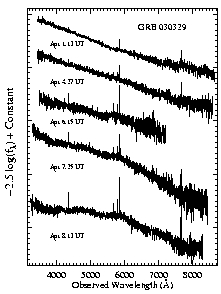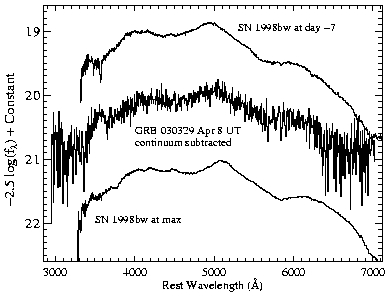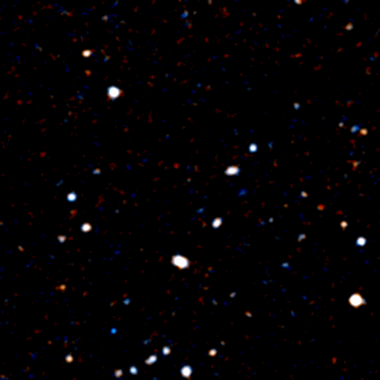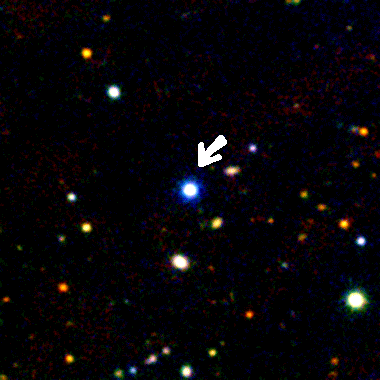

Department News
April 11, 2003To subit material for the news page, click here
NASA Helps Link Gamma Ray Burst & Supernova

Scientists have discovered one of the brightest and closest gamma
ray bursts on record is also a supernova. They obtained the
first direct evidence linking these two types of explosive phenomena, both
triggered by the death of a massive star.
NASA's High-Energy Transient Explorer satellite (HETE) initially
detected the burst on March 29, 2003, in the constellation Leo.
For more than 30 seconds, the burst outshone the entire universe
in gamma rays, and its optical afterglow was still more than a trillion
times brighter than the sun two hours later.
Through observations of the gamma ray burst afterglow, astronomers
spotted the telltale signs of a supernova. Scientists cannot yet
determine which came first, the burst or the supernova, but the
same event, a star explosion, was certainly the trigger for both.
"There should no longer be doubt in anybody's mind that gamma
ray bursts and supernovae are connected," said Dr. Thomas Matheson
of the Harvard-Smithsonian Center for Astrophysics (CfA), Cambridge,
Mass., and a member of the team that made the discovery.
Matheson's colleagues include Dr. Peter Garnavich of Notre Dame and Dr. Krzysztof Stanek of the CfA. Nearly two-dozen scientists, primarily using the Multiple Mirror Telescope (MMT) at Mount Hopkins, Ariz., obtained the data. Several of the MMT spectra were taken by ASU graduate students Nimish Hathi and Luis Echevarria and postdoc Rolf Jansen in Rogier Windhorst's cosmology group. When the burst was discovered, astronomers scheduled to use the MMT agreed to observe it as a target of opportunity in collaboration with Garnavich, Matheson and Stanek.
 |
 |
|
Time evolution of the observed
spectra of the GRB afterglow after the initial burst. |
Comparison of the observed spectral profile of the GRB after subtraction of the signature of the GRB afterglow itself to known local examples of supernovae. |

Gamma ray bursts are the most powerful explosions in
the universe, and they likely signal the birth of black holes. Bursts
occur at random locations scattered across the sky. Few last more than
a minute, making them hard to study.
A supernova is the explosion of a star at least eight times
as massive as the sun. When such stars deplete their nuclear fuel,
they no longer have the energy to support their mass. Their cores
implode, forming either a neutron star or, if there is enough mass,
a black hole. The surface layers of the star blast outward, forming
the colorful patterns typical of supernova remnants.
Previous observations, particularly from NASA's Chandra X-
ray Observatory, have provided convincing indirect evidence
of the gamma ray burst/supernova connection. The Chandra Observatory
detected iron and other heavy elements, which are formed in supernovae,
in the vicinity of gamma ray bursts.

Matheson and the others detected direct evidence the
burst afterglow's
light is exhibiting the same patterns as light from a supernova.
Namely, the scientists see changes in light absorbed by silicon
and iron atoms, forged in the supernova, as the afterglow slowly
fades away. The team is continuing to observe and analyze this unique
burst.
"Scores of observatories, and even more observers, are now
studying this event," said Dr. Donald Kniffen, at NASA Headquarters
in Washington. "We've been searching for a direct link for
decades, and we finally got it," he said.
"All gamma ray bursts may have associated supernovae that
are too faint to observe," Matheson said. The March 29
burst, named GRB 030329, was one of the closest to Earth. It was
approximately two billion light-years away, as opposed to other
bursts located more than 10 billion light-years away. Because the
burst was both relatively close to Earth and bright, the supernova
was detectable.
At top left, a sequence of B/W photographs of the afterglow of GRB03029 observed from Japan. At bottom left, two deep color images of a small field around GRB030329 before (top) and after (bottom) the burst went off (Courtesy: P. Challis, CfA)

|
Copyright © 2000 Arizona Board of Regents |
Physics & Astronomy ASU Tempe, AZ 85287 +1(480)965-3561 Information@asu.edu |
Page Contact: phyastweb@asu.edu |